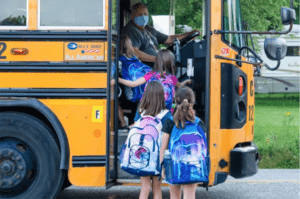By Lola Duffort/VTDigger
Surveillance testing has been touted by Vermont officials as a cornerstone of its Covid-19 mitigation efforts in K-12 schools. But only a little more than one-third of Vermont’s public school districts and a quarter of its private schools will have actually begun testing by the end of September, according to figures provided by state officials.

Kids headed to Hinesburg Elementary School take a dab of hand sanitizer as they get on the bus on the first day of school on Aug. 25.
“The state prioritizes surveillance testing as a key component for keeping schools open and our students and school staff healthy,” Ted Fisher, a spokesperson for the Agency of Education, wrote in an email. “Nonetheless, there have been delays in getting it off the ground as quickly as hoped.”
Surveillance programs test segments of a population in an effort to identify cases early, before they become outbreaks. The state is making weekly testing available to all public and private schools free of charge. All staff and students ages 5 and up, whether vaccinated or not, are eligible to participate.
But Vermont is relying on schools to coordinate and administer the effort on the ground. While more than 90% of all districts have signed up to participate, many school leaders, who are also responsible for contact tracing within their buildings, report being too thinly staffed to carry out the effort anytime soon.
In the Kingdom East School District, lead nurse and Covid-19 coordinator Sophia Hall said she’s already spending nearly 40 hours a week on contact tracing alone and cannot stand up a testing program until mid-October. She doesn’t have extra time to learn how to run the program, she said.
“Great idea, poor timing — beginning of school is always the most time-intense for school nurses with regular commitments for student health,” Hall said. “I am told there may be additional help to administer the program but nothing definite as yet.”
Penny Chamberlin, the superintendent in the Orleans Central Supervisory Union, said her districts were signed up to test only staff for now but plan to expand to students at a later date. “For us it is simple. We don’t have a full-time nurse in every school and are short-staffed, so staffing this process is our concern,” she said.
Every school district that participates must build the framework within the state’s testing database. That’s immensely time-consuming, said Rebecca McCray, the president of the Vermont State School Nurses Association.
Another issue: Consent forms were initially provided only in English, although the state is working to remedy this.
“This is a huge equity issue for health access and creates the question of when it will be possible to roll the surveillance program out for all students at the same time,” said McCray, the lead nurse in the Burlington School District, one of the state’s most diverse districts.
Some superintendents also reported planning to start surveillance testing earlier but being forced to delay the rollout because of problems with the state’s contractor, CIC Health. David Baker, the superintendent in the Windsor Southeast Supervisory Union, said he had been told he could not begin testing until Oct. 7. Brooke Olsen-Farrell, the superintendent in the Slate Valley Unified Union School District, said her district was planning to begin testing Sept. 15 but has now pushed back to Sept. 29.
Setbacks in rolling out surveillance testing in schools comes at a time when the state is recording case count and hospitalization numbers not seen in Vermont since the spring. At least 78 people came into Vermont schools while infectious in the most recent seven-day reporting period published by the Vermont Dept. of Health. There have been five pediatric hospitalizations since the Delta variant arrived in the state.
Fisher said the Agency of Education is surveying schools to see how it might better help them, and “working to accommodate individual [school district] capacity and logistical needs.”
“We take seriously the state’s role in this program and are working hard to improve the onboarding process and remove barriers, as well as making sure CIC Health understands and honors their obligations as the testing provider,” Fisher wrote.




